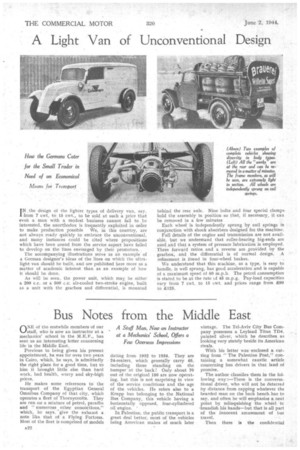A Light Van of Unconventional Design
Page 24

If you've noticed an error in this article please click here to report it so we can fix it.
IN the design of the lighter types of delivery van, say, from 7 cwt. to 15 cwt., to be sold at such a price that even a man with a modest business cannot fail to be interested, the unorthodox is frequently exploited in order to make production possible We, in this country, are not always ready quickly to embrace the unconventional, and many instances could be cited where propositions which have been sound from the service aspect have failed to develop on the lines envisaged by their promoters..
The accompanying illustrations serve as an example of a German designer's ideas of the lines on which the ultra light van should he built, and are published here more as a matter of academic interest than as an example of how it 'should be done.
As will be seen, the power unit, which may be either a 200 c.c. or a 500 c.c-. air-cooled two-stroke engine, built as a unit with the gearbox and differential, is mounted
behind the rear axle. Nine bolts and four special clamps hold the assembly in position so that, if necessary, it can be removed in a few minutes Each wheel is independently sprung by coil springs in conjunction with shock absorbers designed fon the machine.
Full details of the engine and transmission are not available, but we understand that roller-bearing big-ends are used and that a system of pressure lubrication is employed. Three forward ratios and a reverse are ..proVided by the gearbox, and the differential is of normal design. A refinement is found in four-wheel brakes.
We understand that this machine, as a type, is easy to handle, is well sprung, has good acceleration and is capable of a maximum speed of SO m.p.h. The petrol consumption is stated, to be at the rate of 45 m.p.g. Pay-load capacities vary from 7 cwt. to 15 ewt. and prices range from £.90 to £125.




















































